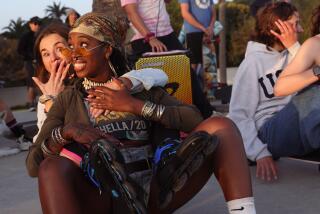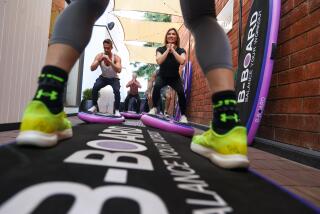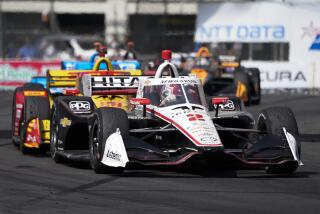A California town in love with old-time longboard skiing
- Share via
Longboards aren’t just for surfers.
In the mid-1800s, half a century before surfing ever came to the Golden State, longboard skiing took off among the young, athletic men in Sierra mining camps who liked to drink, gamble and carouse in their spare time. They strapped on what were called Norwegian “skates” or “snowshoes” — those 12-foot-long wooden skis you see on the walls of old-timey ski resorts — to get from one snowbound cabin to another.
Fast-forward a century and a half to the teensy town of Johnsville (population: 20) northwest of Lake Tahoe, where the locals are still crazy about longboards — so crazy they hold winter competitions every year.
“Plumas County has a really rich skiing history in the Lost Sierra region of California that not many people know about,” says Scott Lawson, director of the Plumas County Museum in nearby Quincy. “The Historic Longboard Revival Series is a way of keeping those traditions alive.”
It happens near Eureka Peak, formerly called Gold Mountain, where miners extracted around $25 million worth of gold in 1853. Events are set for the third Sunday of January, February and March, with the final contest deemed the “world championship” race. Lawson knows of no other longboard races like these anywhere in the West.
Participants wear period costumes and leather boots, which are affixed to skis with just two leather straps. Racers must use hand-crafted longboards, which some participants make themselves. Others are available for rent on a first-come, first-served basis.
Christopher Coughlin, a photographer who moved to Plumas County three years ago from the San Francisco Bay Area, made his own 12-foot-2-inch longboards using only hand tools at a community college class . He plans to race this year, once he gets his technique down.
“Hundreds of people show up to watch these races, and I don’t really want to crash and burn in front of a big crowd,” he says. “So I’m going to need to practice some.
“But just making the skis was a fun process, especially considering that we didn’t use power tools,” Coughlin adds. “I also joined the local ski club and have made a bunch of new friends through it.”
David Matuszak, 66, who lives between Redlands and Yucaipa in Southern California, said he became intrigued by longboard skiing during nearly 40 summers of panning for gold in Plumas County. He wrote a book about his experience in the Mt. Shasta area called “Nelson Point: Portrait of a Northern Gold Rush Town.”
Residents of that community who stuck around for the sometimes very snowy winters competed in longboard races. Matuszak became friends with Lawson, who about a decade ago gave him a pair of longboards to try out on the race course when no one was around.
Matuszak slipped them on and flew down the hill, crashing about 20 feet from the finish.
“Those skis are giant when you’re on them,” he says. “I’ve been a regular snow skier for many years, and the longboards looked like they were 12 feet long in front of me. They freaked me out. When I caught a tip, I tumbled but didn’t get hurt.”
Matuszak finally got around to competing in a race — complete with spectators — last year in Johnsville. He fell again, got back up and completed the course. “But I got across the finish line and got an official time” dressed in an old pair of logging pants, suspenders, a period coat and a cowboy hat, he says.
Longboard competition’s early roots
Perhaps the most famous longboarder from the mid-1800s was Snowshoe Thompson, a Norwegian who delivered the mail on 10-foot skis from Placerville to outposts in the Sierra. He most likely raced a time or two, though probably not in Plumas County.
For the miners’ contests, skiers basically climbed up a snow-covered slope, pushed off with the aid of a single pole, crouched in an aerodynamic tuck and sped down the run on 12- to 15-foot skinny planks of wood with turned-up tips. Ski contests quickly evolved, especially ones you could make money on.
The first documented ski races in the United States were held in 1861 outside Onion Valley between La Porte and Quincy in Plumas County. Miners and mine owners wagered thousands of dollars, with the winner taking home as much as $500, the equivalent of more than $15,000 today.
Lawson, who has taken up the tradition, says he’s gone as fast as 45 mph on longboard runs. But it’s the legendary Cornish Bob, a miner from Cornwall in southwest England, who set a record in 1867. He apparently strapped on a pair of long skis and then flew down a steep, 1,804-foot course near La Porte in front of hundreds of spectators.
His speed: 88.1 mph, thanks in part to treating his skis with secret “dope,” a kind of old-fashioned wax his friend applied to the bottom of his longboards. Ingredients in the dope, a precursor to modern ski wax, included paraffin, tallow and tar, as well as cedar, castor and hemlock oils. One favorite additive was “spermaceti,” which comes from the head of the sperm whale, Lawson says.
To slow down at the bottom of the hill, as the story goes, Cornish Bob dragged a single pole, sending up a huge plume of snow.
How longboards were made
Longboard racers never dared to attempt a turn during or at the end of the race because that would have risked a perilous crash. Skis were designed only to go straight, without edges for turning.
“Falling with a pair of those longboards is like being in the center of a helicopter with them spinning and flailing around your head,” Lawson says. “You could really get hurt.”
The skis — some as long as 15 feet, though 12 feet appears to be the sweet spot — were made by skilled woodworkers, who used two-by-fours planed down at the tail and front and then steamed to curl up the tip. To help with stability, the makers carved a groove down the center to keep skis straight. The groove also made them faster because racers could put a little more dope on their boards.
The sport died out in the 1930s, staged a comeback and then disappeared again in the 1950s. But Rob Russell, a former Plumas Ski Club president, along with Lawson and other enthusiasts, revived the longboard skiing races in 1993. The contests have been held near Johnsville ever since, with strict rules that ban modern waxes in favor of the old dope recipes.
“And no cheatin’ or spittin’ is allowed, either,” says Lawson.
Russell, 66, has won the world championship race at least eight times. And while he continues to compete, he says the competition “is getting a lot stiffer these days, with some pretty fast young men and women coming up.”
One of those racers last year was freestyle skier Jonny Moseley, a gold medalist at the 1998 Winter Olympics in Nagano, Japan.
Lawson said he’s done exhibition runs at Mammoth Mountain, Soda Springs and Squaw Valley resorts, where he hiked up a slope and skied back down. He never dreamed of getting on a chairlift with the long, wooden skis.
“That might be difficult,” he says. “And I’m not sure if they’d even be allowed at a ski area. So if you have a pair of longboards and want to try them out at a resort, you’d probably better ask permission first.”
At the races
The Plumas Ski Club will host the 2020 Historic Longboard Revival Series at noon Jan. 19, Feb. 16 and March 15 at Plumas-Eureka State Park near Johnsville. You pay $20 for membership in the ski club and $20 to race. Beginners are encouraged to participate, as long as they are prepared to crash and learn. Ski rentals ($20) are available for the 18-and-older crowd.
Or you can watch for free. The final championship race in March usually draws crowds of up to 600 people who turn out to watch 30 to 40 racers dressed in mining-era costumes. “We’ve had some people who’ve never been on any kind of skis take part,” Lawson says.
Info: plumasskiclub.org
More to Read
Sign up for The Wild
We’ll help you find the best places to hike, bike and run, as well as the perfect silent spots for meditation and yoga.
You may occasionally receive promotional content from the Los Angeles Times.










